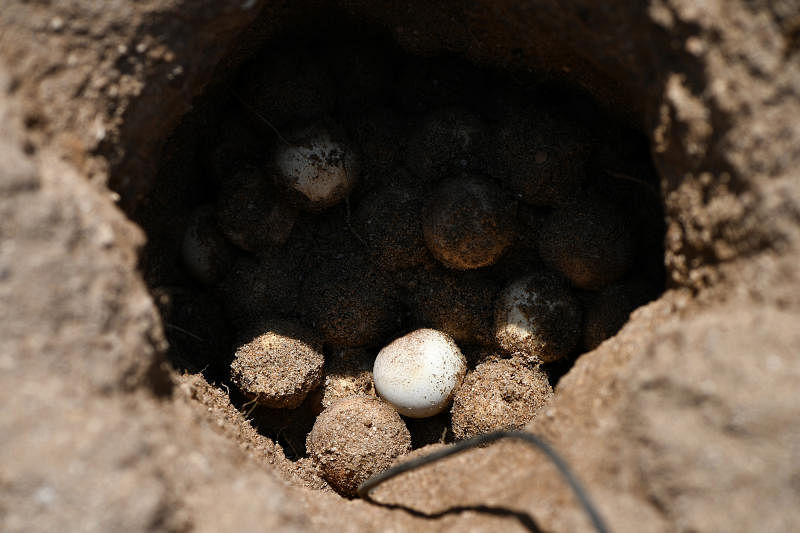NParks moves 152 critically endangered sea turtle eggs from East Coast beach to hatchery
Sign up now: Get ST's newsletters delivered to your inbox
Follow topic:
SINGAPORE - As dawn broke over a stretch of beach along East Coast Park on Wednesday morning (Aug 21), a group of people were huddled over a hole in the ground.
Slowly, carefully, they extracted what looked like ping pong balls from the sand, placing them in a bucket filled with moist sand.
But they were no sportsmen on a treasure hunt. They were staff and volunteers with the National Parks Board (NParks), on a mission to rescue a clutch of 152 eggs laid by a hawksbill turtle, a species of sea turtle that is critically endangered around the world.
After the eggs were retrieved, they were moved to the turtle hatchery on Sisters' Islands Marine Park, where they are likely to hatch within the next few days, according to estimates by NParks researchers.
Removing the eggs was a laborious process, taking the NParks staff and volunteers about an hour to complete the task.
The removal had to be done by hand and without any tools, as rescuers were afraid the use of equipment could damage the eggs.
Scientists also took care not to change the rotation of the eggs, placing them in moist sand so they would not move around.
At the Sisters' Islands hatchery, the eggs were reburied 42cm deep in sand - the same depth they were found at in East Coast Park.

Other than installing motion sensors and temperature gauges around the eggs, a large cage was also placed around them to keep away predators such as long-tailed macaques and monitor lizards.
The nest had been spotted about 50 days ago by a National University of Singapore student researcher who then informed NParks.
After NParks verified the sighting as a nest, a decision was made to move the eggs, as the site was deemed risky for the baby turtles, said Mr Collin Tong, senior manager for the coastal and marine branch of NParks' National Biodiversity Centre.
He told reporters on Wednesday morning: "The nest site is next to a construction site, which is brightly lit at night. We have been told by our volunteers that hatchlings have been spotted hanging out in the waters near the site."
Turtle hatchlings use environmental cues to make their way from sand to sea, including light from the moon.
Light from other sources could confuse the young turtles. But there is no light pollution at the offshore Sisters' Islands, said Mr Tong.
The hope is that when the baby turtles emerge from the hatchery, the females would "imprint" on the Sisters' Islands beach - orienting themselves using Earth's magnetic field to return to Singapore's southern islands to nest when they become sexually mature in 25 years or so.
The hatchery, launched by NParks in September last year, aims to provide a conducive environment for turtle hatchlings to incubate, hatch safely and make it out to sea.
There are two species of sea turtles in Singapore: the hawksbill and green turtles. These reptiles can be directly affected by climate change, as their sexes are influenced by temperatures.
Female turtles hatch in warmer temperatures, whereas males hatch in cooler environments. In a warming world, this could skew the ratio of the sexes.
Mr Tong said NParks is able to control temperatures at the hatchery, maintaining sand temperatures at about 29 deg C, so it is more likely that a mix of male and female turtles would hatch from the clutch.
Hawksbill turtle nests have been spotted along Singapore's eastern coast, from Changi to the beaches along East Coast Park.
However, their nesting grounds may be under threat, if land reclamation works take place along Singapore's eastern coast.
In his National Day Rally speech on Sunday, Prime Minister Lee Hsien Loong said that over the long term, Singapore is looking into major engineering feats to tackle the issue of sea level rise - a symptom of climate change that Singapore, an island state, is especially vulnerable to.
Among the strategies being considered are empoldering, a land reclamation technique, along Singapore's eastern coast, as well as reclaiming a series of offshore islands there. He said all options will be carefully considered before a decision is made.
Asked how the potential reclamation of the area could affect turtle nesting grounds, NParks said: "Agencies are still studying the options for coastal protection measures along the eastern coast to determine the best way forward."
Naturalist Bernard Seah, 50, noted that East Coast Park is currently located on reclaimed land. Turtles are adaptable, he said, and would return to sea if it deems an area unsuitable for nesting.
The NParks volunteer told The Straits Times: "I have mixed thoughts about the possibility that East Coast might be reclaimed further. Singapore needs more land, but we're not sure about how it will affect the turtles.
"But if the development eventually goes ahead and is done in a careful way, such as if it is done in segments, turtles will still have room to nest. This way, a balance can be struck," he said.

